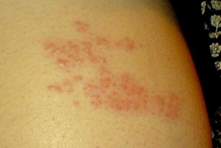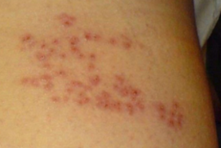There is a 1 in 3 lifetime risk of developing shingles. Even if you have an active lifestyle.
What is Shingles?
Shingles, or herpes zoster, is a characterised by blisters and sharp burning nerve pain in the skin caused by reactivation of the varicella zoster virus (the same virus that causes chickenpox).
95% of adults aged 50 years or older already have the virus that causes shingles. It can be reactivated at any time and the risk increases as the immune system naturally get weaker as we grow older.
The risk of Shingles increases with age.
Most people only experience shingles once, but its possible to get shingles again. In 1 of 3 people, the dormant varicella zoster virus reactivates and causes shingles. Shingles is caused by virus that you already carry, so you cannot protect yourself by social distancing.
What are the symptoms of shingles?
Shingles is typically a painful rash with blisters that form scabs within 7 days to 10 days. It normally takes 2 to 4 weeks for the skin to heal. More than 90% of people who develop shingles feel severe nerve pain and many describe the sensation as aching, burning, stabbing or like electric shocks. 1 to 5 days before the ash first appears, you may have pain, itching, tingling and numbness on an area of the skin where the rash will develop. The rash usually appears as a tripe of blisters on one side of the body, or sometimes on the face along a nerve path. It can develop on the arm, thigh, head – or even the eye or the ear. The most common locations are the chest and the abdomen. The symptoms can also include fever, headaches or feeling generally unwell.
What are some complications?
Shingles is a painful disease that can have serious and long-lasting complications. The most common condition is post-herpetic neuralgia (PHN) with severe pain in the healed area that can last from months up to years. PHN affects up to 20% of people over 50 years of age with shingles. Other complications include scarring, and loss of vision and hearing. The risk of stroke increases in the first year after the onset of shingles.

Day 2 of Shingles

Day 6 of Shingles
No matter how healthy you feel, your immune system gets weaker as you age. This increases the risk of shingles, especially if you are 50 years of age or older.
Can Shingles be Prevented?
Shingles can be prevented through vaccination. Talk to one of our healthcare professionals about Shingles vaccination.
Shingrix vaccine requires two doses two months apart. The effectiveness the Shingrix vaccine at preventing shingles four years after vaccination is:
(Zoe-50 and Zoe 70 studies)
- Ages 50 to 69: 97%
- Ages 70 to 79: 91%
- Ages 80 and older: 91%
Zostavax is a single vaccine. The effectiveness of the Zostavax vaccine at preventing shingles three months after one dose is:
- Ages 50 to 59: 70%
- Ages 60 to 69: 64%
- Ages 70 to 79: 41%
- Ages 80 and older: 41% at 5 years
To access the vaccination service for shingles, you can contact any participating pharmacy or book an appointment online:
- Two-dose Shingles Vaccination Service: Cost is €486 (€243 per dose). The second dose is typically administered two months after the first. You can book an appointment online or contact any participating pharmacy.
- One-dose Shingles Vaccination Service: Cost is €213. (This service is currently not available to book on-line. Please contact the pharmacy directly).
After Care
The Shingles vaccine may cause a strong response in your immune system, so it may produce short-term side effects. These side effects can be uncomfortable, but they are expected and usually go away on their own in 2 or 3 days. You may choose to take over-the-counter pain medicine such as ibuprofen or acetaminophen. Talk to your local Pharmacist for more information.






